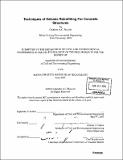Techniques of seismic retrofitting for concrete structures
Author(s)
Bouvier, Charlotte A. (Charlotte Aude Caroline), 1980-
DownloadFull printable version (11.78Mb)
Other Contributors
Massachusetts Institute of Technology. Dept. of Civil and Environmental Engineering.
Advisor
Jerome J. Connor.
Terms of use
Metadata
Show full item recordAbstract
Recent earthquakes, starting with the 1971 San Fernando Earthquake in California, left major destructions, damaged the infrastructure, and raised questions about the vulnerability and design practice of structures, especially concrete structures. Design codes have being updated to include seismic previsions but structures build before 1971 have to be retrofitted. The focus of this paper is concrete structures. Surveys done after earthquakes have shown that the major problem with concrete structures is columns. Pre- 1971 detailing left column with lack of confinement as well as lap-slice in plastic hinge regions creating potential failures in flexure strength and/or ductility, and in shear. Other critical structural elements include, but are not limited to, gravity design frames, footings, shear walls, connections, and beams. There are two major categories of retrofit options for concrete structure; local and global methods. Local methods focus at the element level on a particular member that is deficient and in improving it to perform better. Those methods include adding concrete, steel, or composite to the outside of the member. All three methods are effective but each present some disadvantages: concrete is labor intensive, steel requires heavy construction equipments, and composites have high initial cost. Global methods concentrate at the structure level and retrofit to obtain a better overall behavior of the entire structure. The different global techniques are addition of shear walls or steel bracings, and base isolation. All three methods are effective. Shear walls are usually an expensive solution but they are flexible in their distribution allowing them to be hidden in the architecture. Steel bracings allow for openings but their connections to the existing structure can be problematic. Finally, base isolation is an option that is becoming increasingly popular and that provides good behavior in earthquake for low to mid high structures. The different systems presented all have some advantages and disadvantages and the option chosen for the retrofit depends on the existing structure requirement. The different system presented can be combined to provide more efficient and more flexible retrofit schemes.
Description
Thesis (M.Eng.)--Massachusetts Institute of Technology, Dept. of Civil and Environmental Engineering, 2003. Includes bibliographical references (p. 59-62).
Date issued
2003Department
Massachusetts Institute of Technology. Department of Civil and Environmental EngineeringPublisher
Massachusetts Institute of Technology
Keywords
Civil and Environmental Engineering.